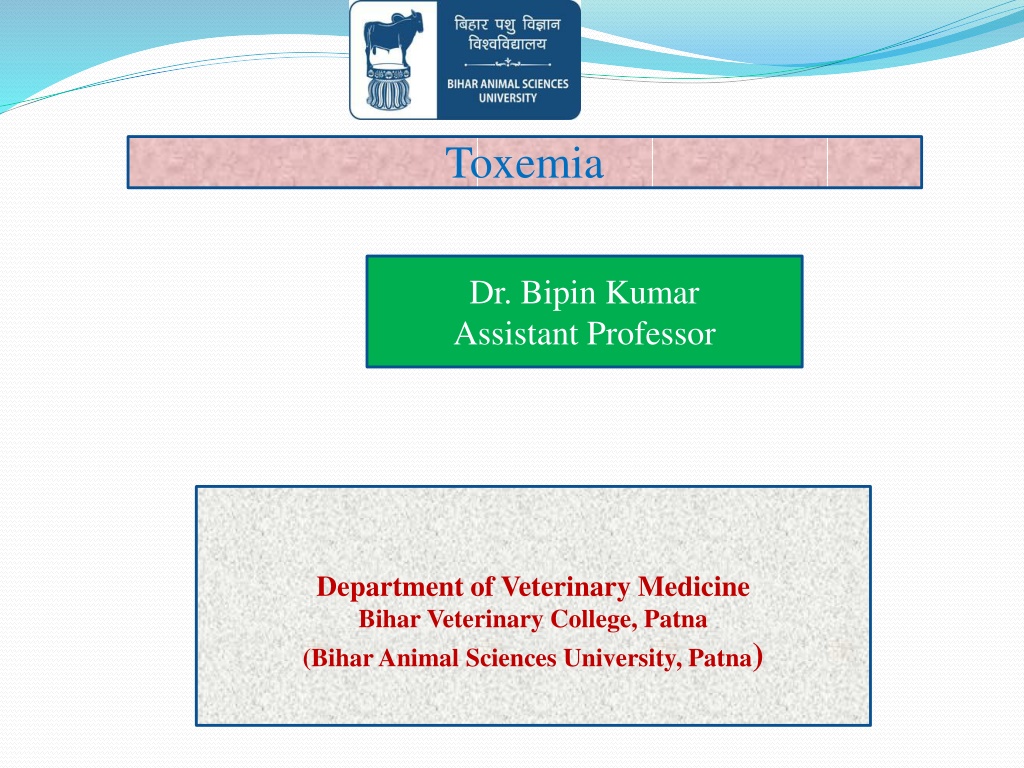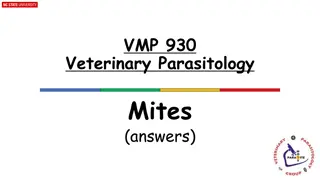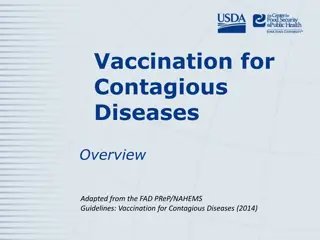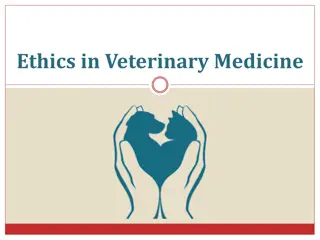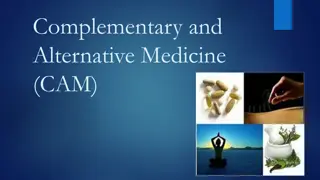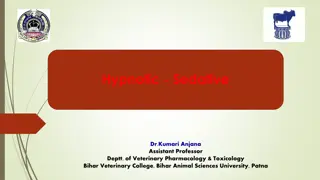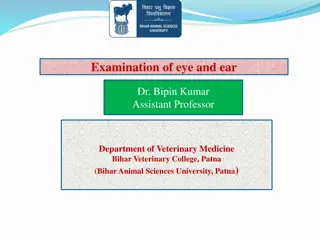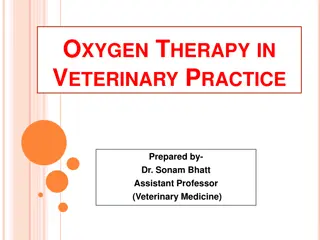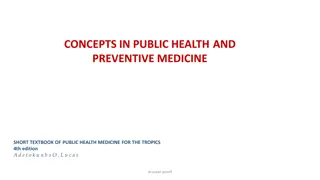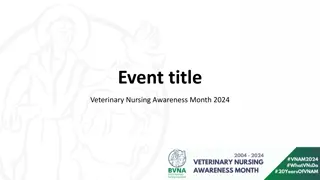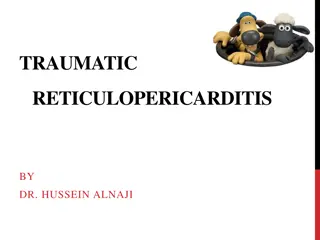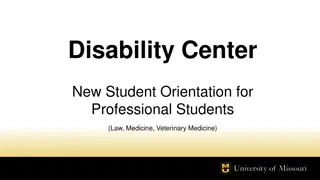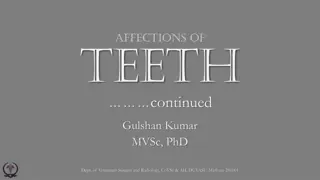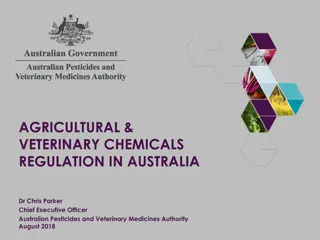Toxemia in Veterinary Medicine
Toxemia is a systemic condition triggered by toxins from bacteria or tissue injury, not plant or insect toxins. Endotoxemia, caused by LPS cell components of Gram-negative bacteria, leads to severe physiological abnormalities. Etiology involves various toxin types, including exotoxins and enterotoxins affecting different body systems. Recognizing and managing toxemia is critical in veterinary practice to prevent fatalities.
Download Presentation

Please find below an Image/Link to download the presentation.
The content on the website is provided AS IS for your information and personal use only. It may not be sold, licensed, or shared on other websites without obtaining consent from the author.If you encounter any issues during the download, it is possible that the publisher has removed the file from their server.
You are allowed to download the files provided on this website for personal or commercial use, subject to the condition that they are used lawfully. All files are the property of their respective owners.
The content on the website is provided AS IS for your information and personal use only. It may not be sold, licensed, or shared on other websites without obtaining consent from the author.
E N D
Presentation Transcript
Toxemia Dr. Bipin Kumar Assistant Professor Department of Veterinary Medicine Bihar Veterinary College, Patna (Bihar Animal Sciences University, Patna)
TOXEMIA Definition Toxemia is a clinical systemic state caused by a widespread activation of host defense mechanisms to the presence of toxins produced by bacteria or injury to tissue. Toxemia does not include the diseases caused by toxic substances produced by plants or insects or ingested organic or inorganic poisons.
Endotoxemia Most common,LPS cell-components of Gram-negative bacteria in the blood, and characterized clinically by abnormalities of many body systems. Alteration of cardiopulmonary function Neutropenia, lymphocytopenia Decreased organ blood flow and metabolism Increased vascular permeability Decreased GIT motility Decreased perfusion of peripheral tissue leading to shock A high case Fatality.
Etiology Toxin Antigenic Metabolic Abnormal metabolism Incomplete excretion Exotoxin Endotoxin
Exotoxins These are protein substances produced by bacteria that diffuse into the surrounding medium. The important bacterial exotoxins are those produced by Clostridium spp., for which commercial antitoxins are available. They may be ingested preformed, as in botulism, or produced in large quantities by heavy growth in the intestines, such as in enterotoxemia, or from growth in tissue, as in blackleg and black disease.
Enterotoxins These are exotoxins that exert their effect principally on the mucosa of the intestine, causing disturbances of fluid and electrolyte balance. The most typical example is the enterotoxin released by enterotoxigenic E. coli, which causes a hypersecretory diarrhea in neonatal farm animals.
Endotoxins The endotoxins of several species of Gram-negative bacteria are a major cause of morbidity and mortality in farm animals. The endotoxins are lipo-polysaccharides found in the outer wall of the bacteria. Endotoxins are released into the immediate surroundings when the bacterial cell wall breaks. Endotoxin gains access to the blood when there is a severe localized infection, such as a coliform mastitis in dairy cattle, or a disseminated infection, such as coliform septicemia in newborn calves.
Metabolic toxin These may accumulate as a result of incomplete elimination of toxic materials normally produced by body metabolism, or by abnormal metabolism Normally, toxic products produced in the alimentary tract or tissues are excreted in the urine and feces or detoxified in the plasma and liver. When these normal mechanisms are disrupted, particularly in hepatic dysfunction, the toxins may accumulate beyond a critical point and the syndrome of toxaemia appears. Examples: ketonemia (ketosis) and lactic acidemia
Clinical signs of Acute toxemia The syndrome varies with the speed and severity of the toxic process but the variations are largely of degrees. Depression, anorexia and muscular weakness are common in acute endotoxemia. Calves do not suck voluntarily and may not have a suck reflex. Scant feces are common but a low-volume diarrhea may also occur. The heart rate is increased and initially the intensity of the heart sounds is increased, but later as the toxaemia worsens the intensity may decrease. The pulse is weak and rapid but regular. A fever is common in the early stages of endotoxemia but later the temperature may be normal or subnormal. Terminally, there is muscular weakness to the point of collapse and death occurs in a coma or with convulsions.
Clinical signs of endotoxemia; Endotoxemia is most commonly associated with bacteremia or septicemia due to infection with gm ve Bacteria. The clinical findings of severe endotoxemia include: Depression Hyperthermia followed by hypothermia Tachycardia followed by decreased cardiac output Decreased systemic blood pressure Cool skin and extremities Diarrhea Congested mucosae with an increased capillary refill time Muscular weakness, leading to recumbency.
Chronic toxemia Lethargy, separation from the group, inappetence, failure to grow or produce and emaciation are characteristic signs of chronic toxemia. Haematological changes Leukocytosis and neutrophilia occur with mild endotoxemia Leukopenia, neutropenia and lymphopenia increase in severity and duration with increasing severity of endotoxemia.
Serum biochemistry A low plasma glucose concentration, high serum urea concentration (nonprotein nitrogen) Low albumin and protein Adults have : Low ca Low Mg Low Ph Low K
Treatment Removal of foci of infection (ambilicus infection in calves) Antimicrobial agent with Gm-ve spectrum Streptomycine Gentamycin Polymyxin B Aggressive fluid therapy IV to restore cardiac output and increase urine output. Lactated ringer solution Isotonic saline solution Hypertonic saline (7.5 % Nacl) or sod. Bicarb may enhance tissue perfusion.
NSAID (analgesic, antipyretic and anti-inflammatory effect) Phenylbutazone Flunixin Glucocorticoid such as dexamethazone to improve cellular metabolism and gluconeogenesis Antisera (hyperimmune serum) Anti-lipid antibodies to bind to LPS preventing inflammatory cascade
